Impacts of Decarbonisation on the Water-Energy-Land (WEL) Nexus: A Case Study of the Spanish Electricity Sector
Abstract
1. Introduction
2. Methodology
2.1. Life Cycle Analysis of Energy Technologies
2.1.1. Definition of the Goal, Data Sources and Main Hypothesis
2.1.2. Description of The Considered Impacts
2.2. Energy Scenario Modelling with TIMES–Spain
2.2.1. Description of the Model
2.2.2. Set of Scenarios
Business as Usual Scenario (BAU)
Target Scenario (TARGET2030)
3. Results and Discussion
3.1. Electricity Mixes Resulting from These Scenarios and CO2 Emissions Associated
3.2. Impacts on the FEW Nexus of the Different Electricity Generation Technologies
3.3. Impacts on the WEL Nexus of the Different Electricity Generation Scenarios
3.3.1. Impacts on Acidification
3.3.2. Impacts on Eutrophication
3.3.3. Impacts on Aquatic Ecotoxicity
3.3.4. Impacts on Water Consumption
3.3.5. Impacts on Land Use
3.3.6. Impacts on Resource Use
3.3.7. Overall Impacts on the Nexus
4. Conclusions
Supplementary Materials
Author Contributions
Acknowledgments
Conflicts of Interest
References
- European Commission (EC). Decision No 406/2009/EC of the European Parliament and of the Council of 23 April 2009 on the Effort of Member States to Reduce Their Greenhouse Gas Emissions to Meet the Community’s Greenhouse Gas Emission Reduction Commitments up to 2020; European Commission (EC): Brussels, Belgium, 2009. [Google Scholar]
- European Commission (EC). Directive 28/2009/EC of the European Parliament and of the Council of 23 April 2009 on the Promotion of the Use of Energy from Renewable Sources and Amending and Subsequently Repealing Directives 2001/77/EC and 2003/30/EC; European Commission (EC): Brussels, Belgium, 2009. [Google Scholar]
- European Commission (EC). Energy. Roadmap 2050. Impact Assessment and Scenario Analysis. Commission Staff Working Paper Impact Assessment. Accompanying the Document Communication from the Commission to the Council, the European Parliament, the European Economic and Social Committee and the Committee of the Regions; Energy Roadmap 2050 {COM(2011) 885 final}. {SEC(2011) 1566 final}. {SEC(2011) 1569 final}; European Commission (EC): Brussels, Belgium, 2011. [Google Scholar]
- European Commission (EC). Communication from the Commission to the European Parliament, the Council, the European Economic and Social Committee and the Committee of the Regions A Policy Framework for Climate and Energy in the Period from 2020 to 2030; {SWD(2014) 15 Final} {SWD(2014) 16 Final}; European Commission (EC): Brussels, Belgium, 2014. [Google Scholar]
- European Commission (EC). EU Reference Scenario 2016. Energy, Transport and GHG Emissions. Trends to 2050. 2016. Available online: https://ec.europa.eu/energy/sites/ener/files/documents/ref2016_report_final-web.pdf (accessed on 18 October 2017).
- Macknick, J.; Newmark, R.; Heath, G.; Hallett, K.C. A Review of Operational Water Consumption and Withdrawal Factors for Electricity Generating Technologies; Technical Report NREL/TP-6A20-50900; National Renewable Energy Laboratory: Golden, CO, USA, 2011.
- International Energy Agency (IEA). Water for Energy. In World Energy Outlook 2012; IEA: Paris, France, 2012; ISBN 978-92-64-18084-0. Available online: http://www.worldenergyoutlook.org/media/weowebsite/2012/WEO_2012_Water_Excerpt.pdf (accessed on 15 November 2017).
- Centro de Estudios y Experimentación de Obras Públicas (CEDEX). Evaluación del Cambio Climático en los Recursos Hídricos en Régimen Natural. Encomienda de Gestión de la Dirección General del Agua (MARM) al CEDEX para el Estudio del Cambio Climático en los Recursos Hídricos y las Masas de Agua; CEDEX: Madrid, Spain, 2010. [Google Scholar]
- Garrido, A.; Willaarts, B.; Rey, L.; López-Gunn, E. Considerations on Climate Variability and Change in Spain. In Water, Agriculture and the Environment: Can We Square the Circle; de Stefano, L., Llamas, M.R., Eds.; Taylor and Francis Group: London, UK, 2012; pp. 191–202. ISBN 978-0-203-09612-3. [Google Scholar]
- Khan, Z.; Linares, P.; García-González, J. Adaptation to climate-induced regional water constraints in the Spanish energy sector: An integrated assessment. Energy Policy 2016, 97, 123–135. [Google Scholar] [CrossRef]
- Valin, H.; Peters, D.; van den Berg, M.; Frank, S.; Havlik, P.; Forsell, N.; Hamelinck, C. The Land Use Change Impact of Biofuels Consumed in the EU. Quantification of Area and Greenhouse Gas Impacts; Project Number: BIENL13120 Commissioned and Funded by the European Commission; International Institute for Applied Systems Analysis (IIASA): Laxenburg, Austria, 2015. [Google Scholar]
- Hastik, R.; Walzer, C.; Haida, C.; Garegnani, G.; Pezzutto, S.; Abegg, B.; Geitner, C. Using the “Footprint” Approach to Examine the Potentials and Impacts of Renewable Energy Sources in the European Alps. Mt. Res. Dev. 2016, 36, 130–140. [Google Scholar] [CrossRef]
- Milner, S.; Holland, R.A.; Lovett, A.; Sunnenberg, G.; Hastings, A.; Smith, P.; Wang, S.; Taylor, G. Potential impacts on ecosystem services of land use transitions to second-generation bioenergy crops in GB. GCB Bioenergy 2016, 8, 317–333. [Google Scholar] [CrossRef] [PubMed]
- Hoff, H. Understanding the Nexus. Background Paper for the Bonn 2011 Conference: The Water, Energy and Food Security Nexus; Stockholm Environment Institute: Stockholm, Sweden, 2011. [Google Scholar]
- Rasul, G. Contribution of Himalayan Ecosystems to Water, Energy, and Food Security in South Asia: A Nexus Approach; International Centre for Integrated Mountain Development (ICIMOD): Kathmandu, Nepal, 2012. [Google Scholar]
- United Nations Economic Commission for Europe (UNECE). Water-Food-Energy-Ecosystems Nexus for Reconciling Different Uses in Transboundary River Basins—UNECE Water Convention; Draft Methodology for the Nexus Assessment for Discussion; United Nations Economic Commission for Europe (UNECE): Geneva, Switzerland, 2013. [Google Scholar]
- Boelee, E.; Hoa, E.; Chiramba, T. UNEP’s Engagement in the Water-Energy-Food Nexus. In Proceedings of the Conference on Sustainability in the Water-Energy-Food Nexus, Bonn, Germany, 19–20 May 2014. [Google Scholar]
- Hoa, E. Governing the Water-Energy-Food Nexus: Opportunities for Basin Organisations, Technical Background Document for Theme 2: “Water-Energy-Food Nexus”. In Proceedings of the First International Environment Forum for Basin Organizations, Nairobi, Kenya, 26–28 November 2014. [Google Scholar]
- World Economic Forum (WEF). Water Security: Water-Food-Energy-Climate Nexus; Dominic, W., Ed.; The World Economic Forum Water Initiative; Island Press: Washington, DC, USA, 2011; ISBN 978-1-59726-735-9. [Google Scholar]
- Food and Agriculture Organisation of the United Nations (FAO). The Water-Energy-Food Nexus at FAO, Concept Note; FAO: Rome, Italy, 2014. [Google Scholar]
- Food and Agriculture Organisation of the United Nations (FAO). Walking the Nexus Talk: Assessing the Water-Energy-Food Nexus in the Context of the Sustainable Energy for All Initiative; FAO: Rome, Italy, 2014. [Google Scholar]
- Andrews-Speed, P.; Bleischwitz, R.; Boersma, T.; Johnson, C.; Kemp, G.; VanDeveer, S.D. The Global Resource Nexus. The Struggles for Land, Energy, Food, Water, and Minerals; Transatlantic Academy: Washington, DC, USA, 2012; Available online: http://www.transatlanticacademy.org/sites/default/files/publications/TA%202012%20report_web_version.pdf (accessed on 21 November 2017).
- World Business Council for Sustainable Development (WBCSD). Co-Optimizing Solutions: Water and Energy for Food, Feed and Fibre; WBCSD: Geneva, Switzerland, 2013. [Google Scholar]
- UN-ESCWA. Conceptual Frameworks for Understanding the Water, Energy and Food Security Nexus; E/ESCWA/SDPD/2015/WP.2, UNESCWA Working Paper; UN-ESCWA: Beirut, Lebanon, 2015. [Google Scholar]
- Al-Saidi, M.; Elagib, N.A. Towards understanding the integrative approach of the water, energy and food nexus. Sci. Total Environ. 2017, 574, 1131–1139. [Google Scholar] [CrossRef] [PubMed]
- Bazilian, M.; Rogner, H.; Howells, M.; Hermann, S.; Arent, D.; Gielen, D.; Steduto, P.; Mueller, A.; Komor, P.; Tol, R.S.J.; et al. Considering the energy, water and food nexus: Towards an integrated modelling approach. Energy Policy 2011, 39, 7896–7906. [Google Scholar] [CrossRef]
- Hadian, S.; Madani, K. A System of Systems Approach to Energy Sustainability Assessment: Are All Renewables Really Green? Ecol. Indic. 2015, 52, 194–206. [Google Scholar] [CrossRef]
- Ringler, C.; Bhaduri, A.; Lawford, R. The nexus across water, energy, land and food (WELF): Potential for improved resource use efficiency? Curr. Opin. Environ. Sustain. 2013, 5, 617–624. [Google Scholar] [CrossRef]
- Konadu, D.D.; Mourão, Z.S.; Allwood, J.M.; Richards, K.S.; Kopec, G.; McMahon, R.; Fenner, R. Land use implications of future energy system trajectories—The case of the UK 2050 Carbon Plan. Energy Policy 2015, 86, 328–337. [Google Scholar] [CrossRef]
- Allouche, J.; Middleton, C.; Gyawali, D. Technical veil, hidden politics: Interrogating the power linkages behind the nexus. Water Altern. 2015, 8, 610–626. [Google Scholar]
- Stigson, P.; Roth, S.; Karlsson, A. Re-evaluating the Sustainability of Energy Systems: The nexus of Energy, Water and Land-Use. In Handbook of Clean Energy Systems; John Wiley and Sons Ltd.: Hoboken, NJ, USA, 2015; pp. 1–14. [Google Scholar] [CrossRef]
- Mouratiadou, I.; Biewald, A.; Pehl, M.; Bonsch, M.; Baumstark, L.; Klein, D.; Popp, A.; Luderer, G.; Kriegler, E. The impact of climate change mitigation on water demand for energy and food: An integrated analysis based on the Shared Socioeconomic Pathways. Environ. Sci. Policy 2016, 64, 48–58. [Google Scholar] [CrossRef]
- Keles, D.; Möst, D.; Fichtner, W. The development of the German energy market until 2030—A critical survey of selected scenarios. Energy Policy 2011, 39, 812–825. [Google Scholar] [CrossRef]
- Willarts, B.A.; De la Rúa, C.; Cabal, H.; Garrido, A.; Lechón, Y. El Nexo Agua-Tierra-Energía en España; Fundación Canal Isabel II; Fundación Canal: Madrid, Spain, 2016; ISBN 978-84-945176-1-7. [Google Scholar]
- Graedel, T.E. On the Future Availability of the Energy Metals. Annu. Rev. Mater. Res. 2011, 41, 323–335. [Google Scholar] [CrossRef]
- Hertwich, E.G.; Gibon, T.; Bouman, E.A.; Arvesen, A.; Suh, S.; Heath, G.A.; Shi, L. Integrated life-cycle assessment of electricity-supply scenarios confirms global environmental benefit of low-carbon technologies. Proc. Natl. Acad. Sci. USA 2015, 112, 6277–6282. [Google Scholar] [CrossRef] [PubMed]
- Santoyo-Castelazo, E.; Azapagic, A. Sustainability assessment of energy systems: Integrating environmental, economic and social aspects. J. Clean. Prod. 2014, 80, 119–138. [Google Scholar] [CrossRef]
- Berrill, P.; Arvesen, A.; Scholz, Y.; Gils, H.G.; Hertwich, E.G. Environmental impacts of high penetration renewable energy scenarios for Europe. Environ. Res. Lett. 2016, 11. [Google Scholar] [CrossRef]
- KIC InnoEnergy. Future Renewable Energy Costs: Onshore Wind. How Technology Innovation Is Anticipated to Reduce the Cost of Energy from European Onshore Wind Farms; BVG Associates: Cricklade, UK, 2014. [Google Scholar]
- International Energy Agency (IEA). Technology Roadmap Solar Photovoltaic Energy, 2014 ed.; Energy Technology Perspectives; IEA: Paris, France, 2014. [Google Scholar]
- KIC InnoEnergy. Future Renewable Energy Costs: Solar-Thermal Electricity. How Technology Innovation Is Anticipated to Reduce the Cost of Energy from European Solar-Thermal Electricity Plants; KIC InnoEnergy: Ag Eindhoven, The Netherlands, 2015. [Google Scholar]
- European Commission (EC) Joint Research Centre (JRC)—Institute for Environment and Sustainability. International Reference Life Cycle Data System (ILCD) Handbook—Recommendations for Life Cycle Impact Assessment in the European Context, 1st ed.; EUR 24571 EN; Publications Office of the European Union: Luxemburg, 2011. [Google Scholar]
- Seppälä, J.; Posch, M.; Johansson, M.; Hettelingh, J.P. Country-dependent Characterisation Factors for Acidification and Terrestrial Eutrophication Based on Accumulated Exceedance as an Impact Category Indicator. Int. J. Life Cycle Assess. 2006, 11, 403–416. [Google Scholar] [CrossRef]
- Posch, M.; Seppälä, J.; Hettelingh, J.P.; Johansson, M.; Margni, M.; Jolliet, O. The role of atmospheric dispersion models and ecosystem sensitivity in the determination of characterisation factors for acidifying and eutrophying emissions in LCIA. Int. J. Life Cycle Assess. 2008, 13, 477–486. [Google Scholar] [CrossRef]
- Struijs, J.; Beusen, A.; van Jaarsveld, H.; Huijbregts, M.A.J. Eutrophication. In ReCiPe 2008 A Life Cycle Impact Assessment Method Which Comprises Harmonised Category Indicators at the Midpoint and the Endpoint Level. Report I: Characterisation Factors, 1st ed.; Ministerie van VROM: Den Haag, The Netherlands, 2008; Available online: https://www.leidenuniv.nl/cml/ssp/publications/recipe_characterisation.pdf (accessed on 15 November 2017).
- Rosenbaum, R.K.; Bachmann, T.M.; Gold, L.S.; Huijbregts, M.A.; Jolliet, O.; Juraske, R.; Koehler, A.; Larsen, H.F.; MacLeod, M.; Margni, M.; et al. USEtox—the UNEP-SETAC toxicity model: Recommended characterisation factors for human toxicity and freshwater ecotoxicity in life cycle impact assessment. Int. J. Life Cycle Assess. 2008, 13, 532. [Google Scholar] [CrossRef]
- Milà i Canals, L.; Romanyà, J.; Cowell, S.J. Method for assessing impacts on life support functions (LSF) related to the use of ‘fertile land’ in life cycle assessment (LCA). J. Clean. Prod. 2007, 15, 1426–1440. [Google Scholar] [CrossRef]
- Frischknecht, R.; Steiner, R.; Jungbluth, N. The Ecological Scarcity Method—Eco-Factors 2006. A Method for Impact Assessment in LCA; Environmental Studies No. 0906; Federal Office for the Environment: Bern, Switzerland, 2009; 188p. [Google Scholar]
- Guinée, J.B.; Gorrée, M.; Heijungs, R.; Huppes, G.; Kleijn, R.; de Koning, A.; Van Oers, L.; Sleeswijk, A.; Suh, S.; Udo de Haes, H.A.; et al. Handbook on Life Cycle Assessment: Operational Guide to the ISO Standards; Series: Eco-Efficiency in Industry and Science; Kluwer Academic Publishers: Dordrecht, The Netherlands, 2002. [Google Scholar]
- European Commission (EC). Report on Critical Raw Materials for the EU; Report of the Ad hoc Group on Defining Critical Raw Materials; European Commission (EC): Brussels, Belgium, 2014. [Google Scholar]
- Loulou, R.; Remme, U.; Kanudia, A.; Lehtila, A.; Goldstein, G. Documentation for the TIMES Model—PART I: TIMES Concepts and Theory; Energy Technology Systems Analysis Programme: Paris, France, 2005. [Google Scholar]
- Loulou, R.; Remme, U.; Kanudia, A.; Lehtila, A.; Goldstein, G. Documentation for the TIMES Model—PART II: Reference manual; Energy Technology Systems Analysis Programme: Paris, France, 2005. [Google Scholar]
- Loulou, R.; Labriet, M. ETSAP-TIAM: The TIMES integrated assessment model Part I: Model structure. Comput. Manag. Sci. 2008, 5, 7–40. [Google Scholar] [CrossRef]
- García-Gusano, D. A Long-Term Analysis of the Spanish Environmental Policies Using the Life Cycle Assessment Method and Energy Optimization Modelling; CIEMAT Editorial: Madrid, Spain, 2014; ISBN 978-84-7834-715-5. [Google Scholar]
- Labriet, M.; Cabal, H.; Lechón, Y.; Giannakidis, G.; Kanudia, A. The implementation of the EU Renewable Directive in Spain. Strategies and challenges. Energy Policy 2010, 38, 2272–2281. [Google Scholar] [CrossRef]
- Cabal, H.; Lechón, Y.; García, D.; Gargiulo, M.; Labriet, M.; Tosato, G. Description of the Updated TIMES-Spain Model; Project COMET. Integrated Infrastructure for CO2 Transport and Storage in the West Mediterranean Collaborative. Project FP7-ENERGY 2009; CIEMAT: Madrid, Spain, 2011. [Google Scholar]
- García-Gusano, D.; Garraín, D.; Dufour, J. Prospective life cycle assessment of the Spanish electricity production. Renew. Sustain. Energy Rev. 2017, 75, 21–34. [Google Scholar] [CrossRef]
- Boletín Oficial del Estado (BOE). Real Decreto-ley 1/2012, de 27 de Enero, por el que se Procede a la Suspensión de los Procedimientos de Preasignación de Retribución y a la Supresión de los Incentivos Económicos para Nuevas Instalaciones de Producción de Energía Eléctrica a Partir de Cogeneración, Fuentes de Energía Renovables y Residuos. Decree Law 1/2012, BOE n 24. 2012; 8068–8072. [Google Scholar]
- European Commission (EC). Directive 81/2008/EC of the European Parliament and the Council on National Emission Ceilings for Certain Pollutants (NEC Directive); European Commission (EC): Brussels, Belgium, 2008. [Google Scholar]
- Boletín Oficial del Estado (BOE). Referencia: BOE-A-2005-895, Madrid, España, por el que se Establece la Relación de Actividades Potencialmente Contaminantes del suelo y los Criterios y Estándares para la Declaración de Suelos Contaminados. Royal Decree 9/2005, BOE n 15. 14 January 2005. [Google Scholar]
- European Commission (EC). Directive 75/2001/EC of the European Parliament and of the Council of 24 November 2010 on Industrial Emissions (Integrated Pollution Prevention and Control); European Commission (EC): Brussels, Belgium, 2001. [Google Scholar]
- European Environmental Agency (EEA). Exposure of Ecosystems to Acidification, Eutrophication and Ozone. 2012. Available online: https://www.eea.europa.eu/data-and-maps/indicators/exposure-of-ecosystems-to-acidification-2/exposure-of-ecosystems-to-acidification-3 (accessed on 25 September 2017).
- International Energy Agency (IEA). Energy Technology Perspectives 2010. Scenarios and Strategies to 2050; Organisation for Economic Co-Operation and Development (OECD)/IEA: Paris, France, 2010. [Google Scholar]
- Latunussa, C.E.L.; Ardente, F.; Blengini, G.A.; Mancini, L. Life Cycle Assessment of an innovative recycling process for crystalline silicon photovoltaic panels. Sol. Energy Mater. Sol. Cells 2016, 156, 101–111. [Google Scholar] [CrossRef]
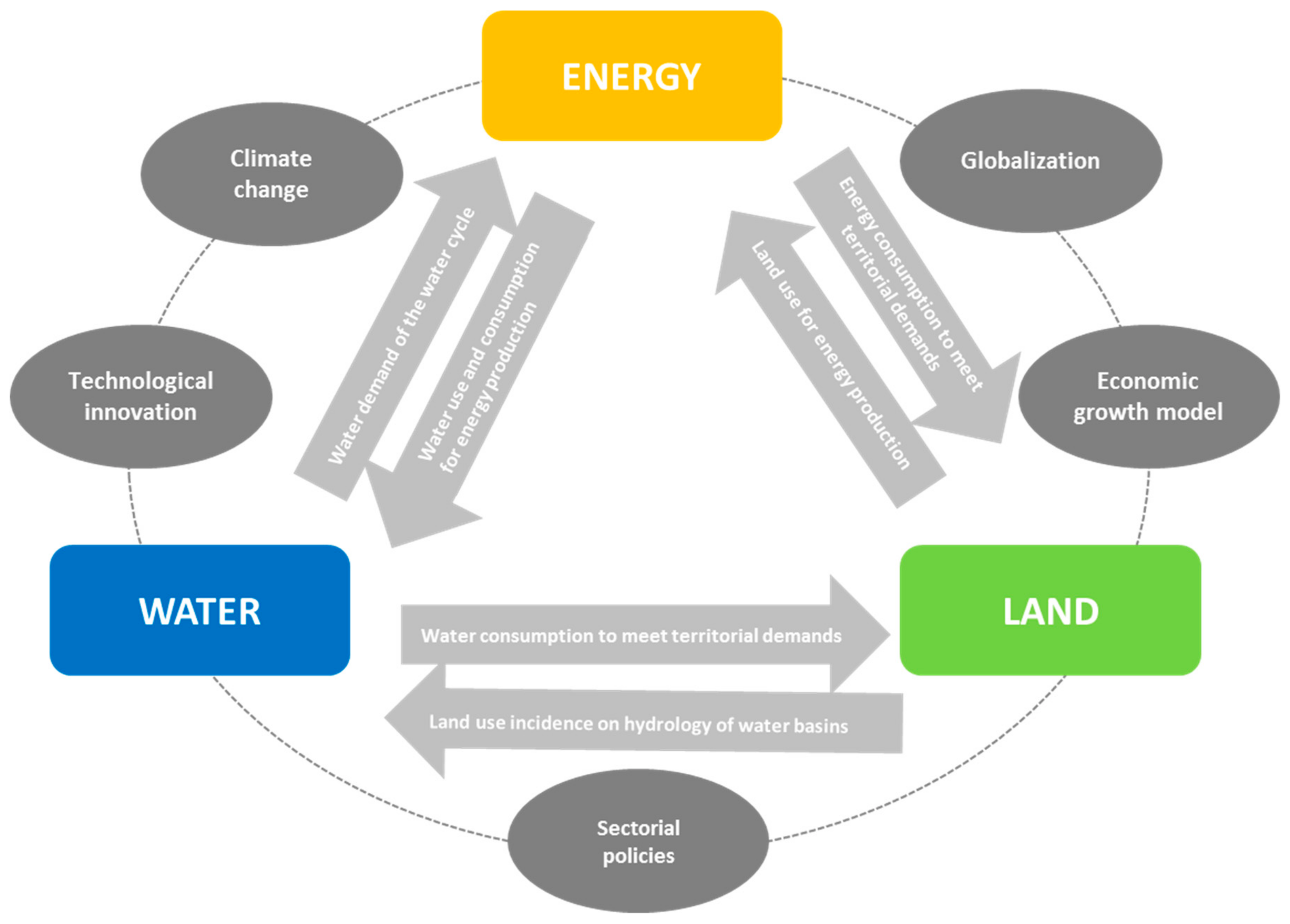
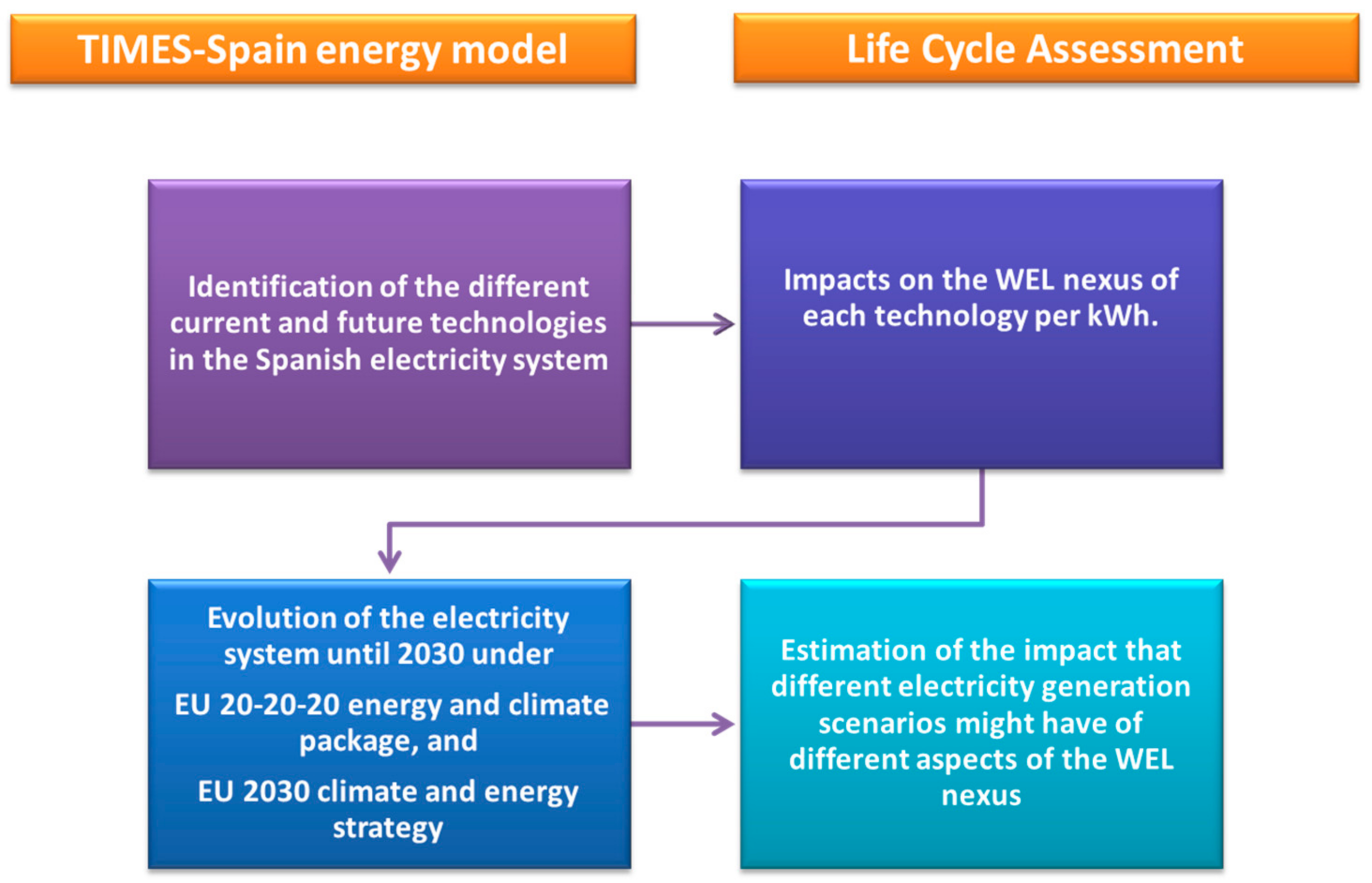
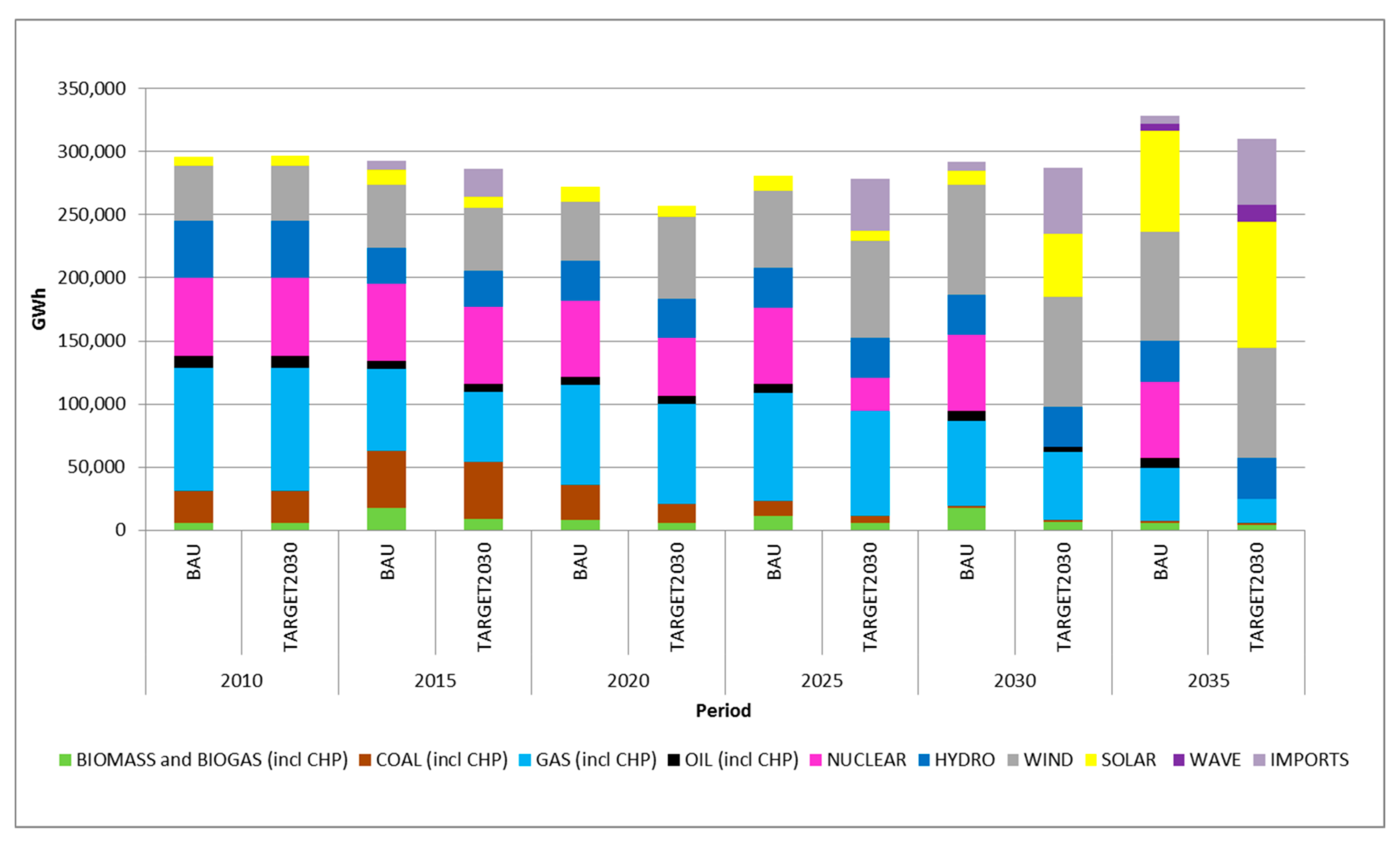
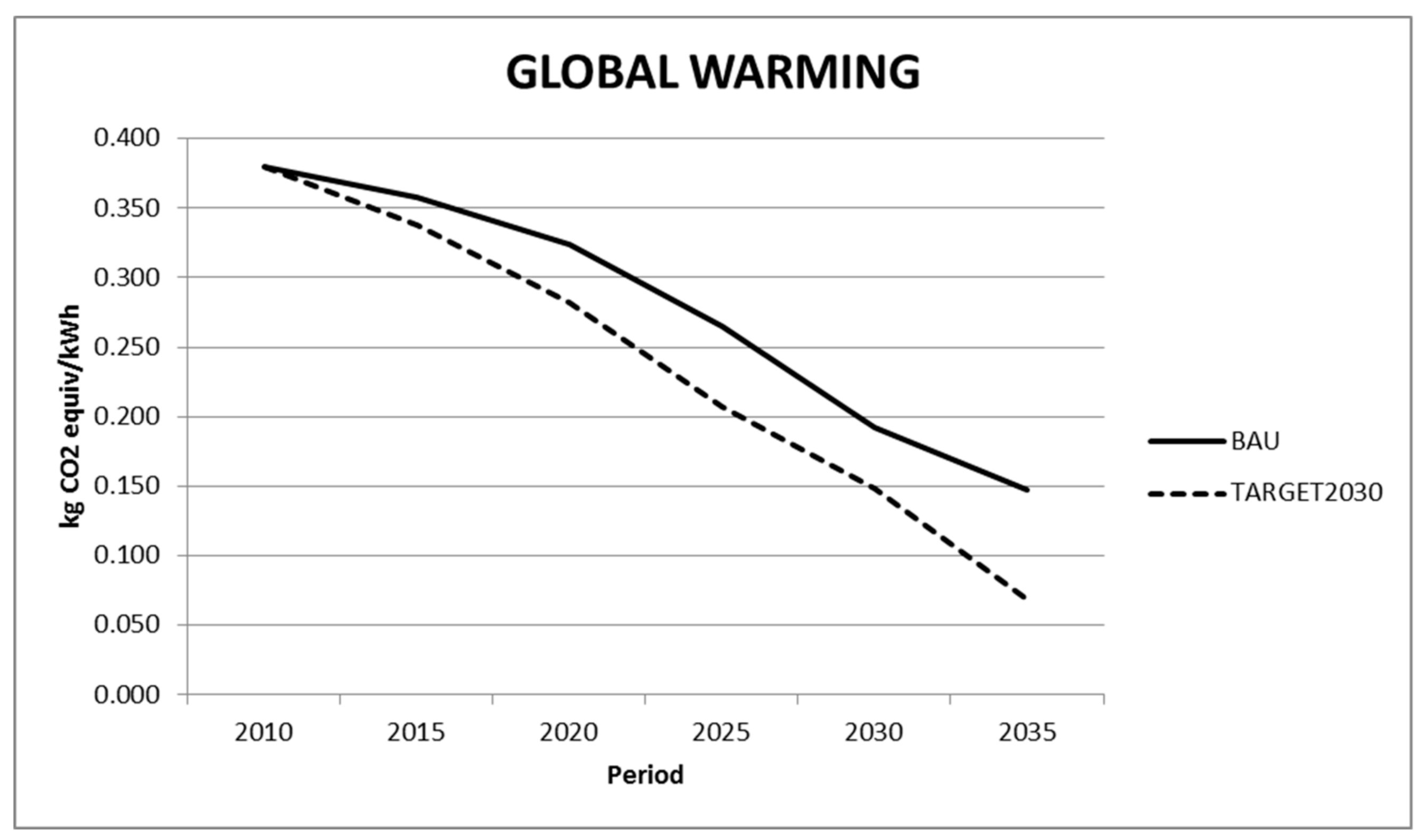
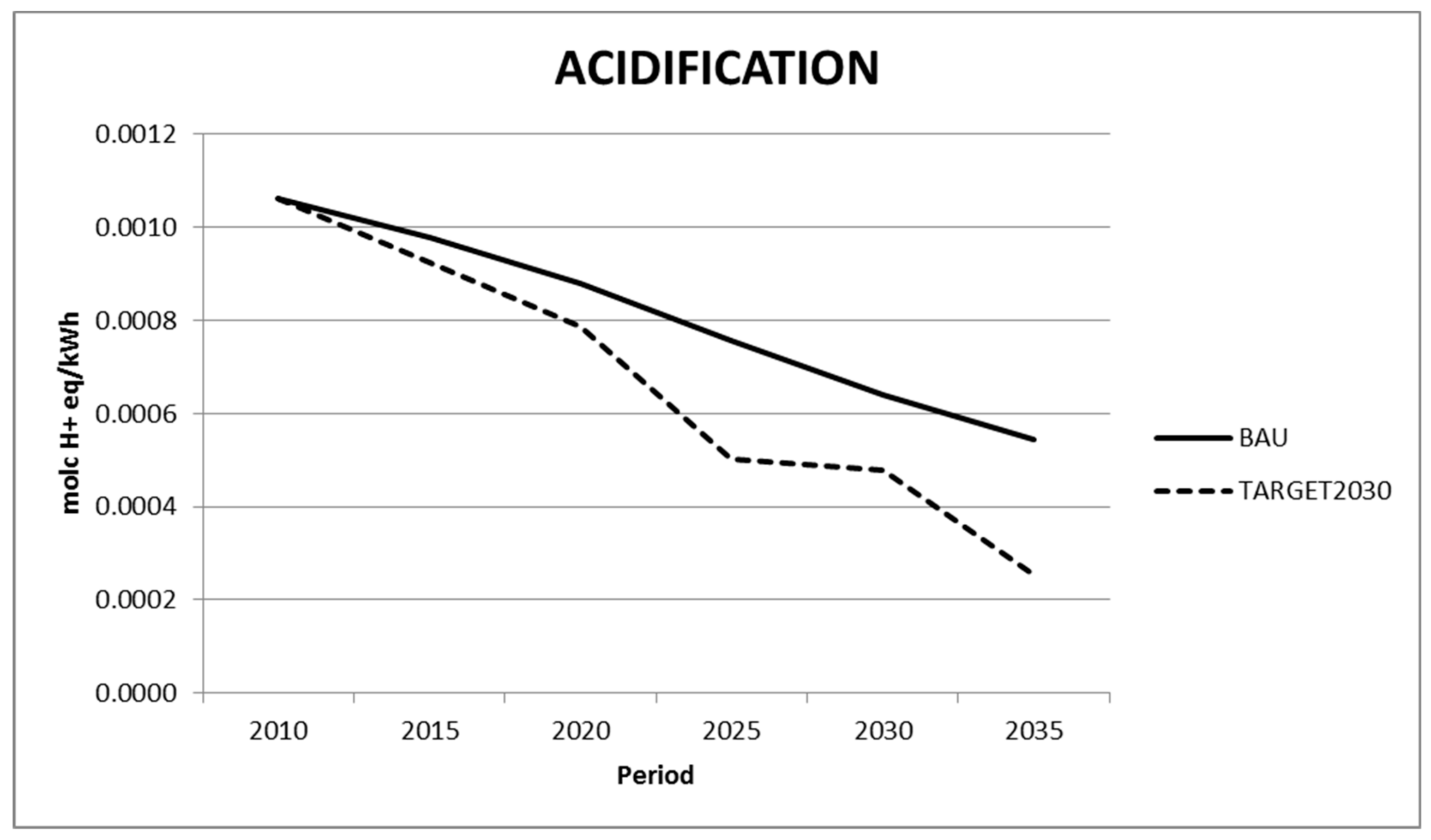
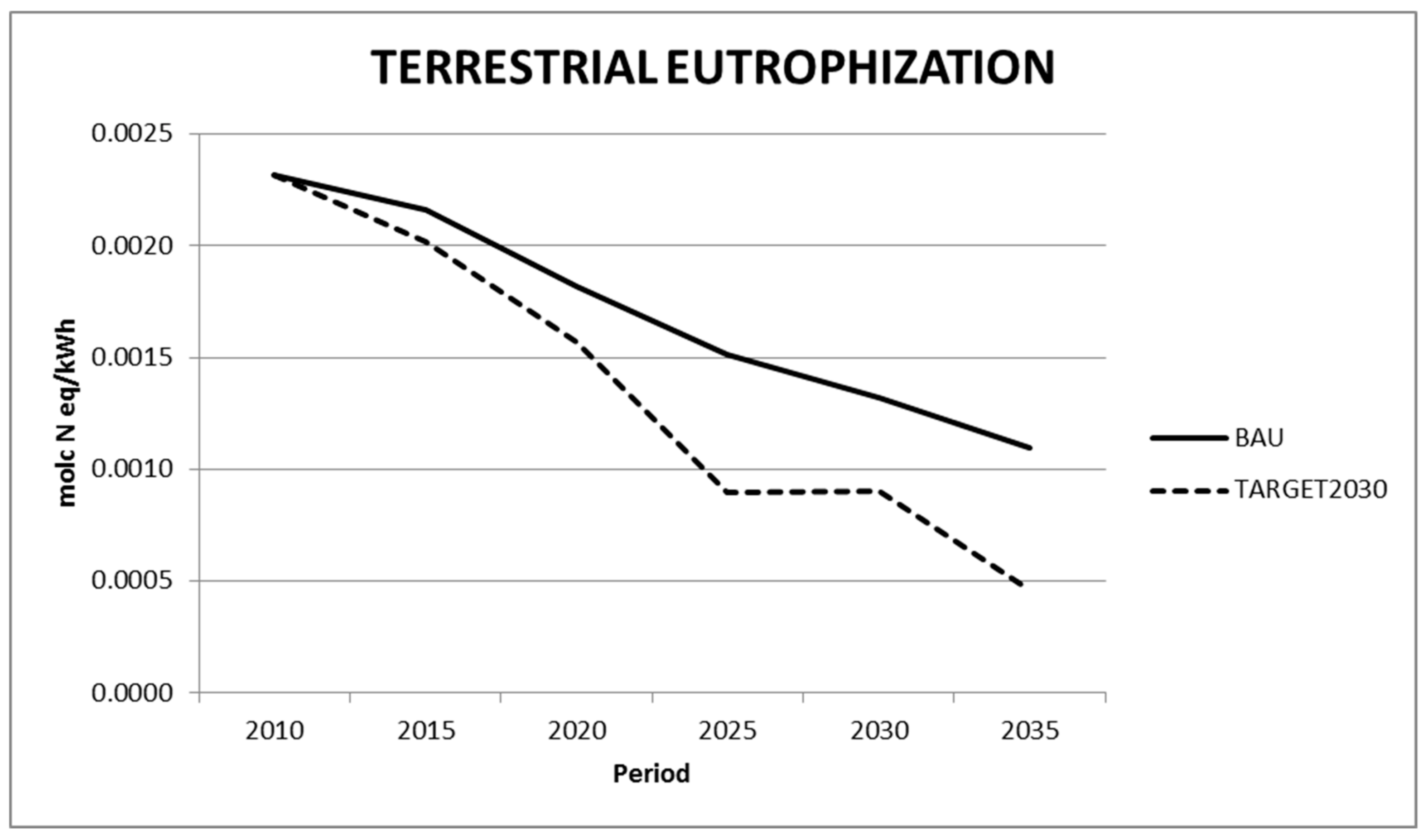
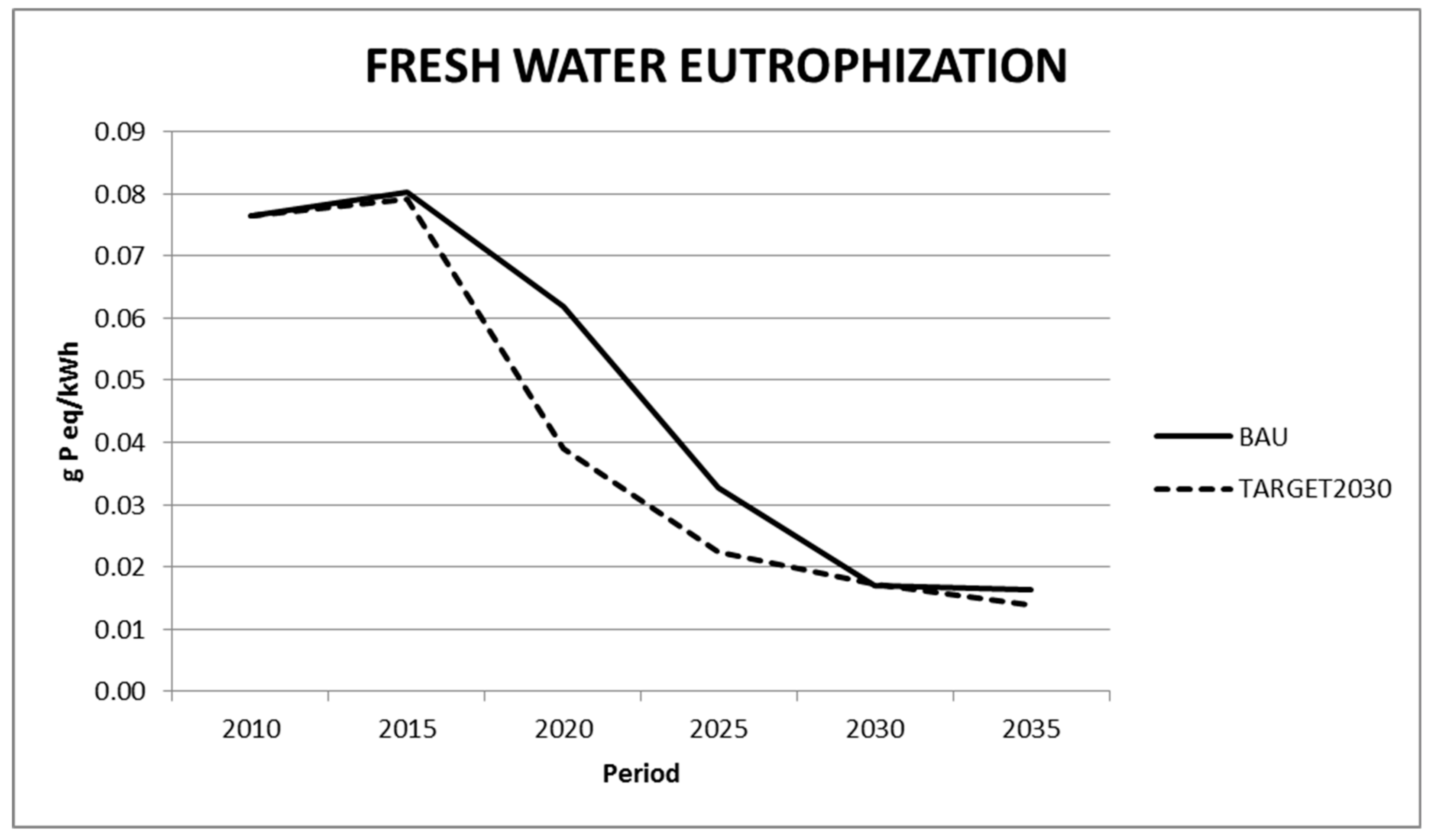
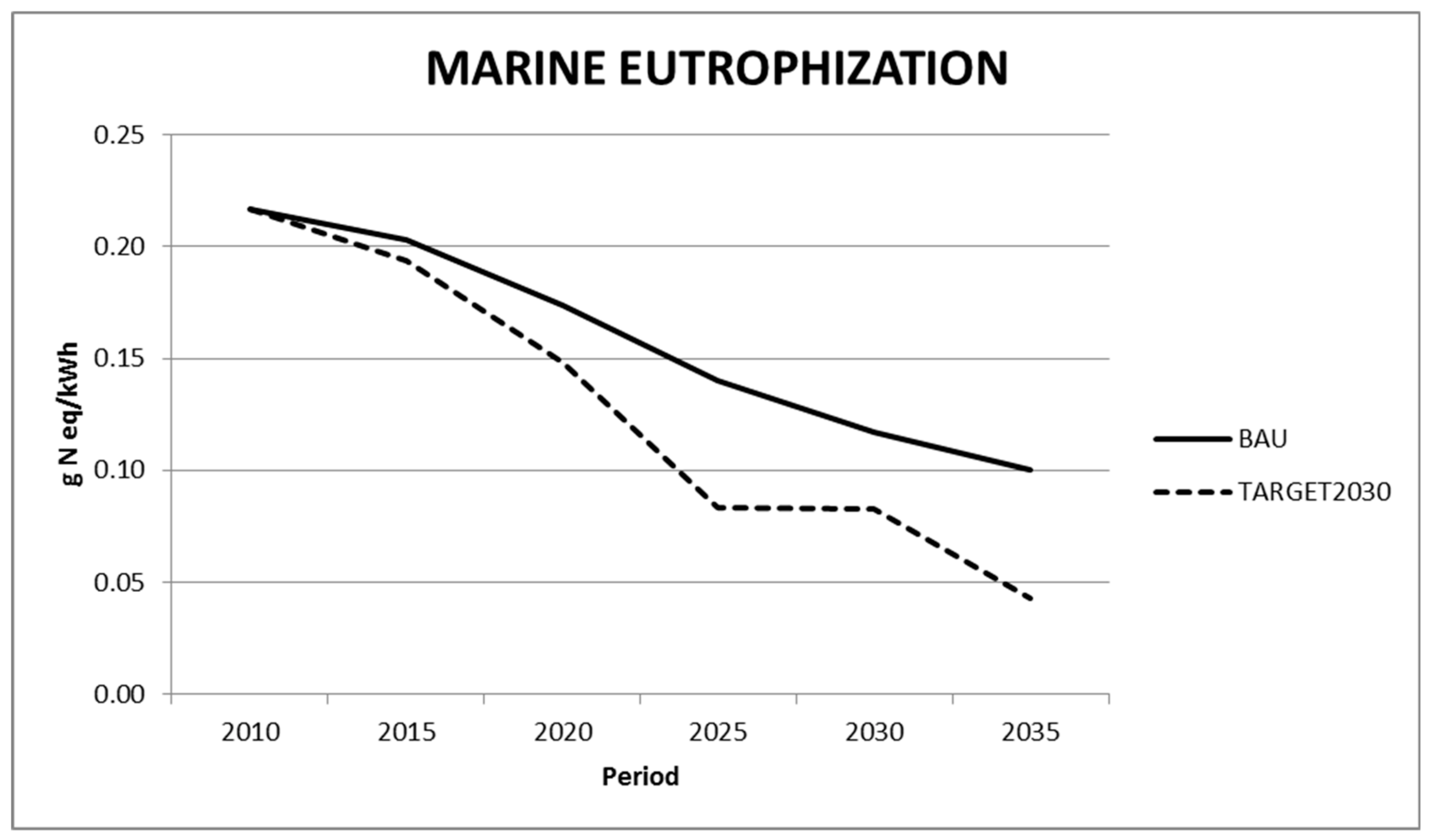

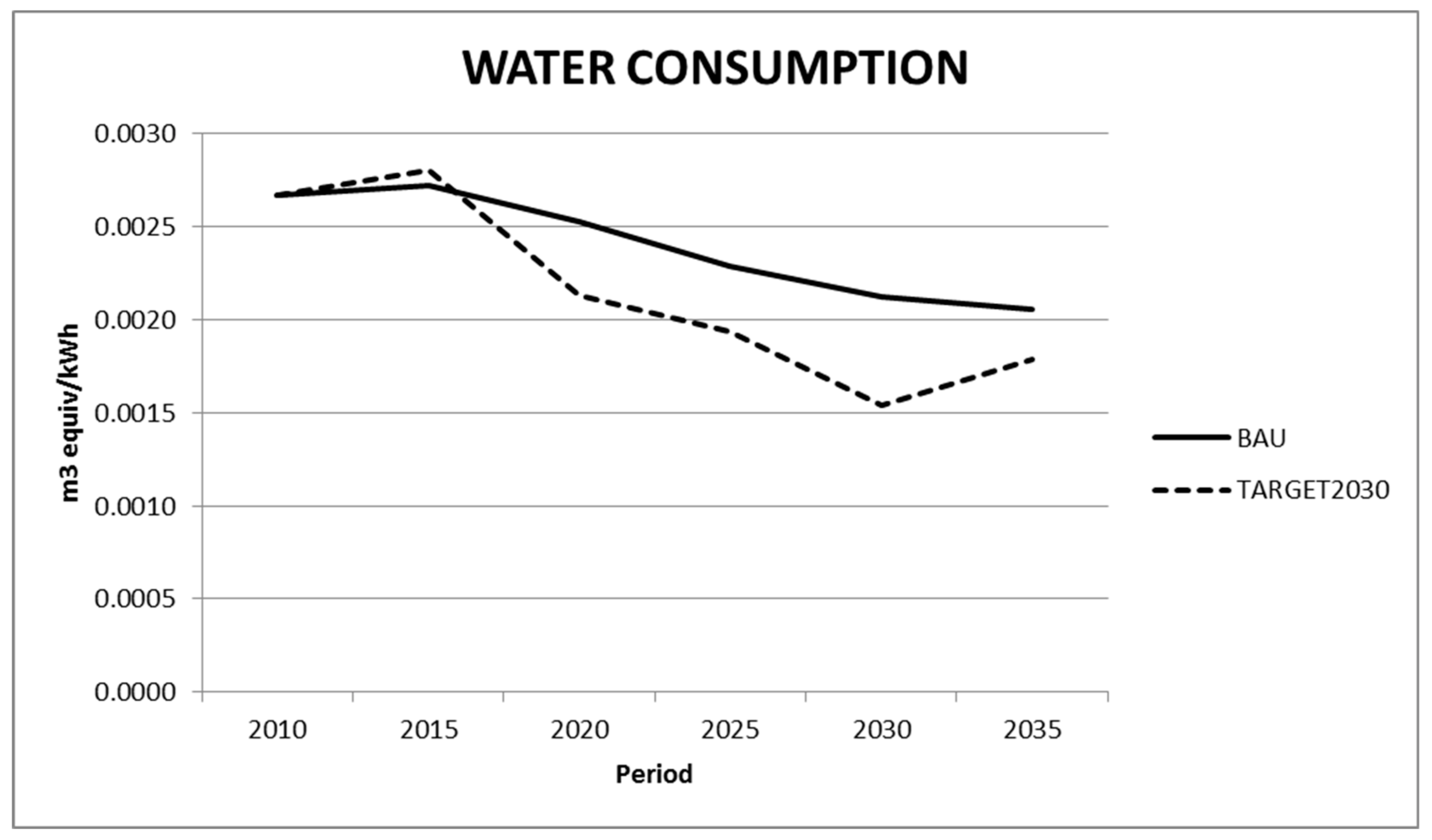

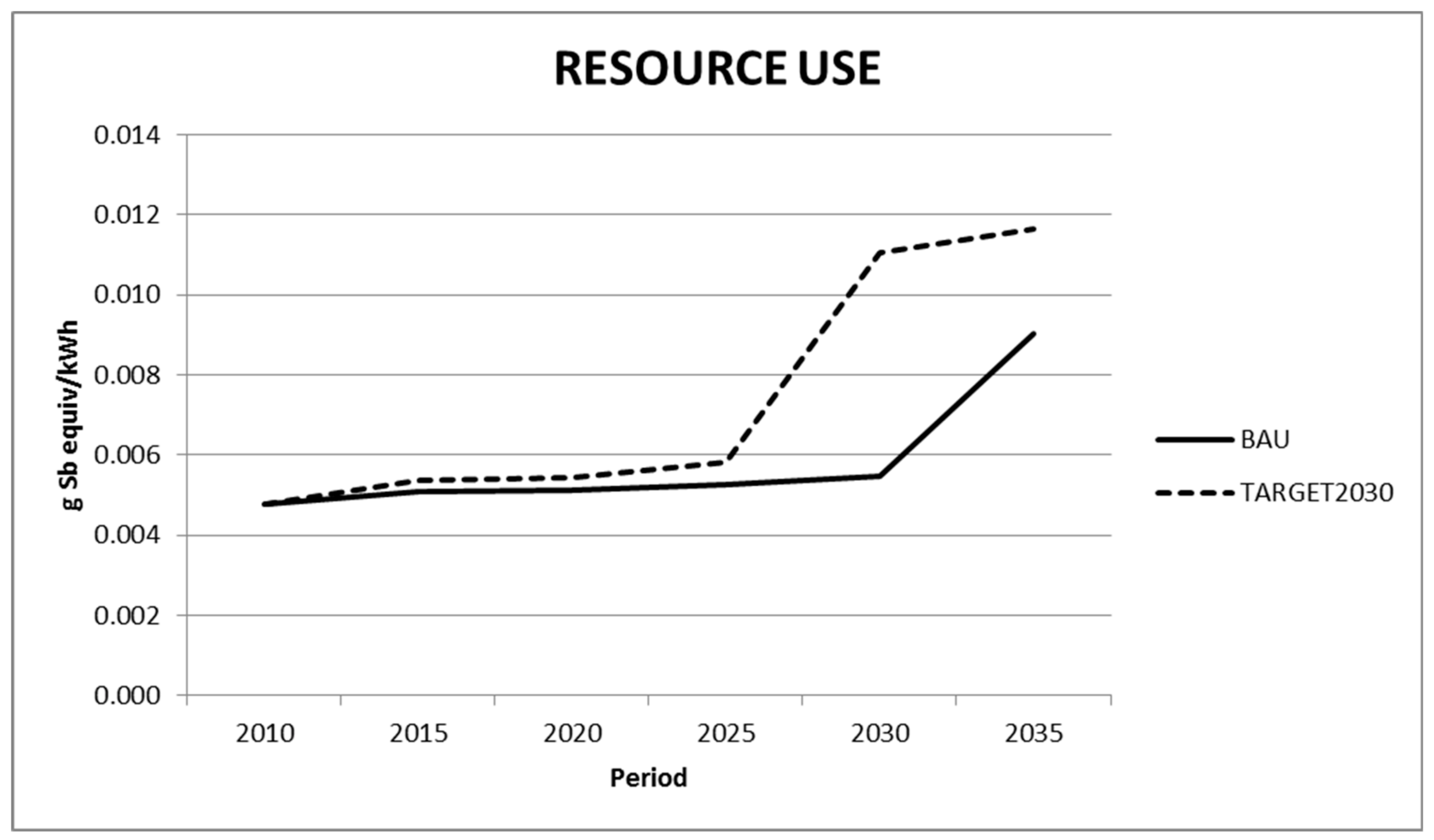
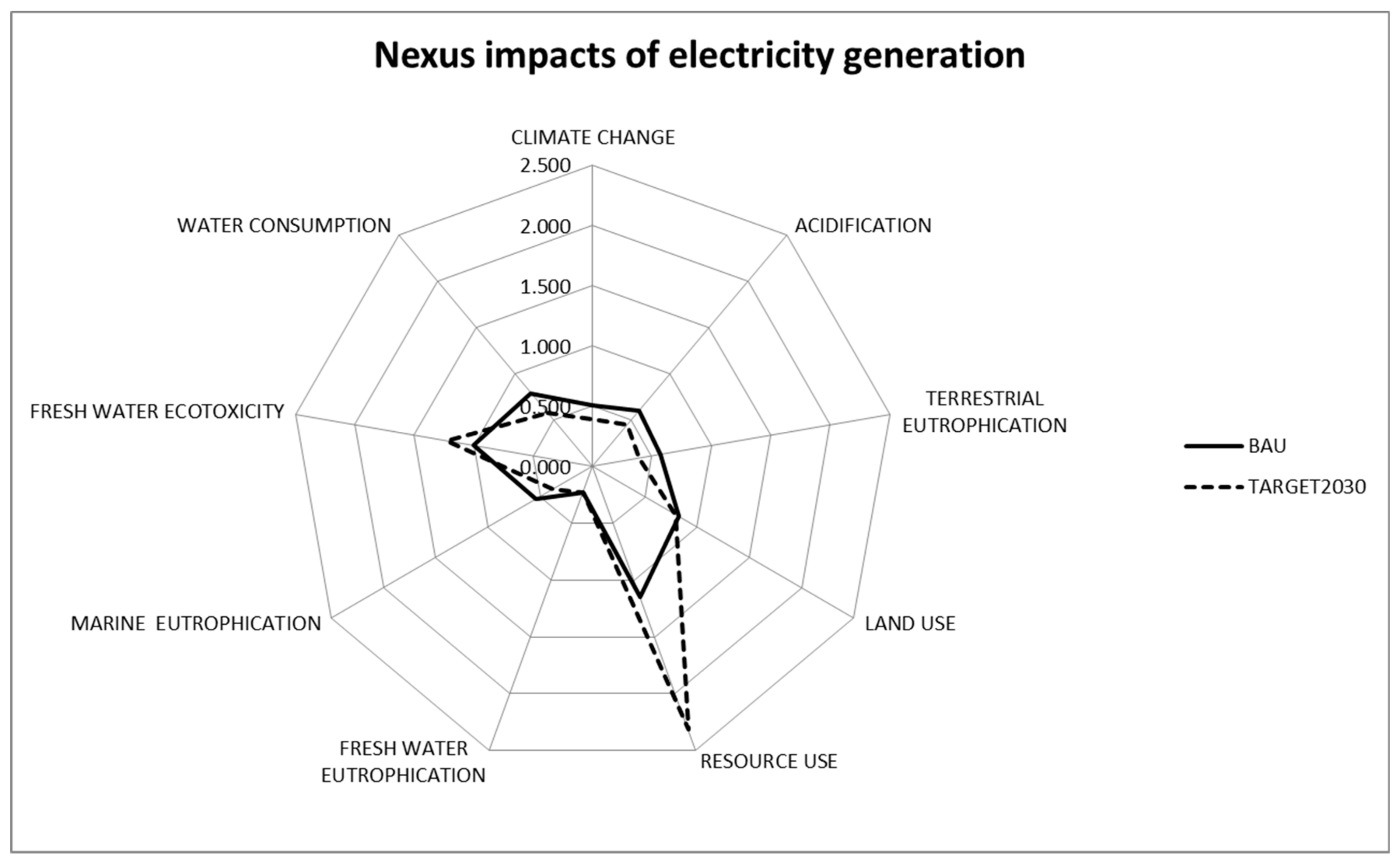
| Socioeconomic Drivers | 2005 | 2010 | 2015 | 2020 | 2025 | 2030 | 2035 |
|---|---|---|---|---|---|---|---|
| Gross domestic product (GDP) (Billion € Constant 2005 prices) | 909 | 948 | 962 | 1116 | 1171 | 1273 | 1384 |
| Average GDP growth in the following 5 years period | 1.7% | −0.3% | 2.7% | 1.5% | 1.7% | 1.7% | 1.6% |
| Population (million inhabitants) | 43.30 | 46.49 | 46.45 | 46.11 | 45.76 | 45.42 | 45.09 |
| Acidification | Terrestrial Eutrophication | Fresh Water Eutrophication | Marine Eutrophication | Fresh Water Ecotoxicity | Land Use | Water Consumption | Resource Use | |
|---|---|---|---|---|---|---|---|---|
| molc H+ eq | molc N eq | kg P eq | kg N eq | CTUe | kg C deficit | l water eq | kg Sb eq | |
| Biogas | 1.31 × 10−3 | 4.18 × 10−3 | 5.37 × 10−5 | 2.20 × 10−4 | 1.78 | 4.47 × 10−1 | 4.08 × 10−1 | 3.95 × 10−6 |
| Biogas Chp | 3.77 × 10−4 | 1.20 × 10−3 | 1.55 × 10−5 | 6.34 × 10−5 | 5.12 × 10−1 | 1.29 × 10−1 | 1.17 × 10−1 | 1.14 × 10−6 |
| Natural Gas Chp | 1.70 × 10−3 | 2.98 × 10−3 | 3.51 × 10−5 | 2.78 × 10−4 | 6.50 × 10−1 | 5.93 × 10−1 | 4.75 | 1.14 × 10−6 |
| Natural Gas Cc Chp | 1.19 × 10−3 | 1.82 × 10−3 | 2.36 × 10−5 | 1.71 × 10−4 | 3.77 × 10−1 | 3.94 × 10−1 | 1.57 | 7.20 × 10−7 |
| Biomass Chp | 9.26 × 10−4 | 3.58 × 10−3 | 4.10 × 10−5 | 1.94 × 10−4 | 5.10 × 10−1 | 6.21 × 10−1 | 3.21 | 1.56 × 10−6 |
| Coal | 2.57 × 10−3 | 6.21 × 10−3 | 4.25 × 10−4 | 6.30 × 10−4 | 3.42 | 3.31 × 10−1 | 3.79 | 1.48 × 10−6 |
| Lignite | 1.57 × 10−3 | 3.92 × 10−3 | 2.92 × 10−3 | 9.48 × 10−4 | 18.9 | 1.66 × 10−1 | 11.1 | 8.63 × 10−7 |
| Csp Current Tech | 5.97 × 10−4 | 1.23 × 10−3 | 2.30 × 10−5 | 1.03 × 10−4 | 4.28 × 10−1 | 2.14 × 10−1 | 8.19 | 1.20 × 10−6 |
| Csp Future Tech with Gas | 6.90 × 10−4 | 1.39 × 10−3 | 2.65 × 10−5 | 1.19 × 10−4 | 4.81 × 10−1 | 2.43 × 10−1 | 3.88 | 1.33 × 10−6 |
| Csp Future Tech without GAS | 7.08 × 10−5 | 1.50 × 10−4 | 3.25 × 10−6 | 1.18 × 10−5 | 9.66 × 10−2 | 6.76 × 10−2 | 4.93 | 3.11 × 10−7 |
| Natural GAS Combined Cycle | 9.67 × 10−4 | 1.48 × 10−3 | 1.92 × 10−5 | 1.38 × 10−4 | 3.06 × 10−1 | 3.20 × 10−1 | 1.46 | 5.84 × 10−7 |
| Minihydro | 1.74 × 10−5 | 5.91 × 10−5 | 1.03 × 10−6 | 5.44 × 10−6 | 2.70 × 10−2 | 9.75 × 10−3 | 1.07 × 10−2 | 1.87 × 10−7 |
| Hydro Dam | 2.19 × 10−5 | 7.02 × 10−5 | 1.34 × 10−6 | 6.45 × 10−6 | 2.99 × 10−2 | 2.79 × 10−2 | 1.74 × 10−2 | 2.68 × 10−7 |
| Nuclear | 1.11 × 10−4 | 2.00 × 10−4 | 6.00 × 10−6 | 2.13 × 10−5 | 4.32 × 10−1 | 1.44 × 10−2 | 4.93 | 5.12 × 10−6 |
| Waves | 2.13 × 10−5 | 9.82 × 10−5 | 3.26 × 10−11 | 7.84 × 10−6 | 2.08 × 10−3 | -8.11 × 10−3 | 0.00 | 0.00 |
| Oil | 7.46 × 10−3 | 1.81 × 10−2 | 1.35 × 10−5 | 1.66 × 10−3 | 6.74 × 10−1 | 5.45 × 10−1 | 3.51 | 1.63 × 10−6 |
| PV Current Tech Mix | 5.73 × 10−4 | 7.84 × 10−4 | 4.56 × 10−5 | 8.08 × 10−5 | 4.27 | 4.50 × 10−1 | 3.17 | 7.63 × 10−5 |
| PV Roof Current Tech | 7.99 × 10−4 | 9.88 × 10−4 | 7.92 × 10−5 | 1.08 × 10−4 | 10.9 | 8.84 × 10−2 | 4.22 | 9.85 × 10−5 |
| PV Roof Future Tech | 2.71 × 10−4 | 3.78 × 10−4 | 2.05 × 10−5 | 3.86 × 10−5 | 1.68 | 2.50 × 10−1 | 1.51 | 3.67 × 10−5 |
| PV Plant Current Tech | 5.43 × 10−4 | 7.57 × 10−4 | 4.10 × 10−5 | 7.71 × 10−5 | 3.36 | 5.00 × 10−1 | 3.02 | 7.33 × 10−5 |
| PV Plant Future Tech | 3.09 × 10−4 | 3.74 × 10−4 | 3.11 × 10−5 | 4.16 × 10−5 | 4.58 | 3.44 × 10−2 | 1.31 | 4.56 × 10−5 |
| Wind Current | 1.28 × 10−4 | 2.44 × 10−4 | 1.08 × 10−5 | 2.42 × 10−5 | 3.97 | 1.59 × 10−1 | 1.68 × 10−1 | 7.74 × 10−6 |
| Wind Medium Term | 1.09 × 10−4 | 2.07 × 10−4 | 9.11 × 10−6 | 2.05 × 10−5 | 3.37 | 1.35 × 10−1 | 1.43 × 10−1 | 6.56 × 10−6 |
| Wind Future | 1.00 × 10−4 | 1.91 × 10−4 | 8.40 × 10−6 | 1.89 × 10−5 | 3.10 | 1.24 × 10−1 | 1.31 × 10−1 | 6.05 × 10−6 |
| Imports 2015 | 1.39 × 10−4 | 3.01 × 10−4 | 6.81 × 10−6 | 2.75 × 10−5 | 5.76 × 10−1 | 4.03 × 10−2 | 4.09 | 5.32 × 10−6 |
| Imports 2020 | 1.42 × 10−4 | 3.17 × 10−4 | 7.84 × 10−6 | 2.77 × 10−5 | 8.92 × 10−1 | 6.04 × 10−2 | 3.68 | 6.10 × 10−6 |
| Imports 2025 | 1.53 × 10−4 | 3.50 × 10−4 | 8.64 × 10−6 | 2.98 × 10−5 | 1.13 | 7.59 × 10−2 | 3.40 | 6.71 × 10−6 |
| Imports 2030 | 1.57 × 10−4 | 3.53 × 10−4 | 9.20 × 10−6 | 3.02 × 10−5 | 1.26 | 8.39 × 10−2 | 3.28 | 7.61 × 10−6 |
| Imports 2035 | 1.57 × 10−4 | 3.54 × 10−4 | 9.23 × 10−6 | 3.03 × 10−5 | 1.27 | 8.44 × 10−2 | 3.28 | 7.63 × 10−6 |
© 2018 by the authors. Licensee MDPI, Basel, Switzerland. This article is an open access article distributed under the terms and conditions of the Creative Commons Attribution (CC BY) license (http://creativecommons.org/licenses/by/4.0/).
Share and Cite
Lechón, Y.; De La Rúa, C.; Cabal, H. Impacts of Decarbonisation on the Water-Energy-Land (WEL) Nexus: A Case Study of the Spanish Electricity Sector. Energies 2018, 11, 1203. https://doi.org/10.3390/en11051203
Lechón Y, De La Rúa C, Cabal H. Impacts of Decarbonisation on the Water-Energy-Land (WEL) Nexus: A Case Study of the Spanish Electricity Sector. Energies. 2018; 11(5):1203. https://doi.org/10.3390/en11051203
Chicago/Turabian StyleLechón, Yolanda, Cristina De La Rúa, and Helena Cabal. 2018. "Impacts of Decarbonisation on the Water-Energy-Land (WEL) Nexus: A Case Study of the Spanish Electricity Sector" Energies 11, no. 5: 1203. https://doi.org/10.3390/en11051203
APA StyleLechón, Y., De La Rúa, C., & Cabal, H. (2018). Impacts of Decarbonisation on the Water-Energy-Land (WEL) Nexus: A Case Study of the Spanish Electricity Sector. Energies, 11(5), 1203. https://doi.org/10.3390/en11051203






